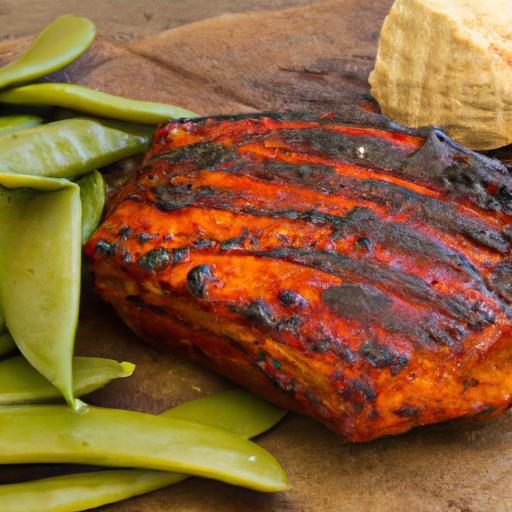When it comes to BBQ, it’s easy to get caught up in sauces, marinades, and the cut of meat, but there’s one unsung hero quietly shaping every bite: the grill grate. These sturdy metal grids are more than just a platform for your food-they are the secret architects behind those coveted sear marks, smoky flavor, and ideal cooking temperature. In “Grill Grates Uncovered: The Secret to Perfect BBQ Cooking,” we peel back the layers on these vital tools, exploring how material, design, and care transform your backyard grill into a culinary powerhouse. Get ready to unlock the full potential of your BBQ and elevate your grilling game to smoky, charred perfection.
Grill grates uncovered reveal the true secret to perfect BBQ cooking, transforming every backyard barbecue into a flavorful masterpiece. Choosing the right grill grate material is foundational-not only does it influence heat retention and distribution, but it also affects the durability and the smoky essence infused into each sear. With a nuanced understanding of materials, heat mastery, meticulous cleaning, and innovative designs, you’ll confidently craft flawlessly cooked barbecue every time.
Choosing the Perfect Grill Grate Material for Flavor and Longevity
Whether you crave those coveted sear marks or desire a rust-free, long-lasting setup, selecting your grill grate material is essential. Cast iron grates offer exceptional heat retention and deliver that classic smokey char beloved by grilling enthusiasts. Meanwhile, stainless steel grates provide excellent corrosion resistance and a sleek finish, making cleanup effortless. Porcelain-coated steel grates bridge the gap-offering non-stick ease while preserving durability.
- Cast Iron: Superior heat retention and durability, but requires seasoning for rust prevention.
- Stainless Steel: Rust-resistant, easy to clean, great for high-temperature grilling.
- Porcelain-Coated Steel: Non-stick surface, less maintenance, visually appealing.
Mastering Heat Distribution for Even Cooking
Optimal heat distribution is the game-changer for beautifully cooked barbecue. Grill grates uncovered often show uneven charring due to hotspots or poor heat conductivity. Materials like cast iron thrive by holding steady heat, creating consistent grill marks while minimizing flare-ups. Stainless steel grates, though less retentive, excel when combined with cleverly designed ventilation and heat shields, enabling you to harness radiant heat and convection evenly across your cooking surface.
Essential Cleaning and Maintenance to Prolong Grill Grate Life
Maintaining your grill grates in pristine condition keeps your barbecue flavors intact and prolongs their lifelong service. After every cook, brush off residue with a high-quality grill brush and wind down with a heat cycle to burn off lingering bits. For cast iron, periodic seasoning with high-smoke point oil fortifies the surface, preventing oxidation. Stainless steel grates benefit from routine polishing and timely acid-based cleaners, like vinegar or lemon juice, to restore luster and deter stains.
Innovative Grill Grate Designs That Elevate Your BBQ
Modern grill grates are engineered to create both visual flair and practical benefits. Wave-shaped or reversible grates expand cooking versatility, while adjustable height settings allow you to fine-tune proximity to the heat source for precision control. Removable sections accommodate different cooking styles-smoking low and slow or searing fast-without changing the entire grate. Such innovations empower you to elevate everyday grilling into culinary artistry.
Prep and Cook Time
- Preparation: 10 minutes (choosing and seasoning/cleaning grill grates)
- Cooking: Variable, depending on food item-typically 15 to 30 minutes for most BBQ staples
Yield
Designed for all grillers: optimizes results for personal meals to large family gatherings.
Difficulty Level
Medium – Combines equipment knowledge with practical grilling experience.
Ingredients for a Perfect Grill Setup
- 1 high-quality cast iron, stainless steel, or porcelain-coated grill grate
- 1 bottle of high-smoke point oil (grapeseed, canola, or avocado oil)
- Grill brush with stainless steel bristles
- Mild soap and vinegar or lemon juice for cleaning
- Protective gloves for handling hot grates
Instructions: Ultimate Grill Grate Preparation and Maintenance
- Inspect the grill grate for rust or residue. Remove loose debris with a grill brush while the grate is cool.
- If cast iron, season the grate: Coat lightly with oil and heat the grill to 450°F. Place the grate on the grill for 30 minutes to allow the oil to polymerize, forming a protective layer.
- For stainless steel or porcelain-coated grates, wash gently with mild soap and warm water, then rinse thoroughly. Avoid abrasive pads to maintain the protective surface.
- Preheat your grill: Allow grates to heat for 10-15 minutes on high to burn off residues.
- Brush grates once more with a grill brush to clear any residual buildup before placing your food.
- During cooking, monitor flare-ups and adjust heat zones to maintain even temperature across the cooking surface.
- After grilling, brush the grate again while still warm to remove fresh residue, then apply a thin coat of oil to prevent rust, especially with cast iron.
Chef’s Notes: Tips for Success
- For cast iron grates, avoid soaking in water; wipe clean and reseason regularly to keep the surface slick and rust-free.
- Stainless steel grates may develop dark discolorations-polishing with a specialized cleaner restores shine.
- Consider investing in interchangeable grate inserts for added versatility, such as flat griddles or pizza stone modules.
- Store grill grates in a dry place or cover your grill to avoid weather-related damage.
Serving Suggestions
Present your impeccably grilled fare atop freshly polished grill grates to showcase perfect sear marks. Garnish with fresh herbs like rosemary or thyme to enhance the smoky aroma. Serve alongside rustic sides such as grilled corn on the cob, vibrant charred vegetables, or a classic BBQ rub-infused tomato salsa. A drizzle of compound butter melting seductively over hot steaks or seafood carries the grill’s essence straight to the plate.
| Nutritional Element | Per Serving |
|---|---|
| Calories | 0 (Grill grates are non-caloric, seasoning and oils vary) |
| Durability | Cast Iron: 10+ years with care |
| Heat Retention | Cast Iron: High, Stainless Steel: Moderate |
| Maintenance Level | Cast Iron: Moderate, Stainless Steel: Low |
Discover more barbecue techniques and gain confidence in mastering your grill. For authoritative guidance on materials and cooking methods, check out the Serious Eats grill grate materials guide.

Q&A
Q&A: Grill Grates Uncovered – The Secret to Perfect BBQ Cooking
Q1: Why do grill grates matter so much in BBQ cooking?
A1: Grill grates are the unsung heroes of BBQ-they’re the direct contact point between your food and the flame. They regulate heat distribution, create those iconic sear marks, and help develop flavor through the Maillard reaction. Without quality grates, even the best meat can turn out lackluster.
Q2: What materials should I look for in a grill grate?
A2: The classic contenders are stainless steel, cast iron, and porcelain-coated cast iron. Stainless steel is durable and rust-resistant; cast iron offers unbeatable heat retention and perfect sears but needs upkeep to prevent rust; porcelain coatings add ease of cleaning and prevent sticking while protecting the metal underneath.
Q3: How does the shape and size of grill grates affect cooking?
A3: The thickness, spacing, and pattern of grates influence airflow and heat retention. Thicker grates hold heat longer, giving even cooking and that coveted char. Closer spacing supports smaller foods like veggies, preventing them from slipping through, while wider spacing encourages smoky flare-ups ideal for briskets and ribs.
Q4: Can the cleanliness of grill grates really impact flavor?
A4: Absolutely! A clean grate prevents off-flavors from old grease and char residue. Plus, a lightly seasoned grate can build up natural non-stick properties that enhance flavor by allowing fats to caramelize beautifully instead of burning unevenly or sticking.
Q5: What secret BBQ tip involves grill grates?
A5: The secret is “preheating and oiling.” Preheat your grate for at least 15 minutes to achieve high, even heat, then oil it just before placing your food. This simple act prevents sticking and ensures that glossy crust that foodies crave-unlocking your grill’s full potential.
Q6: How often should grill grates be replaced?
A6: It depends on use and material. Porcelain-coated grates might chip after a few years; stainless and cast iron can last decades with proper care. When rust becomes pervasive, or grates warp and no longer cook evenly, it’s time to invest in new ones to keep your BBQ game strong.
Q7: Any final advice for mastering grill grate magic?
A7: Embrace patience-great BBQ is a slow dance with your grill. Nurture your grates like a prized instrument: clean, season, and respect their quirks. Perfect BBQ isn’t just about the meat, but the grate that delivers flavor. Happy grilling!
To Conclude
As the final embers glow and the savory aroma of your perfectly grilled feast lingers in the air, it’s clear that mastering grill grates is no secret-just good science and a dash of care. These unsung heroes of BBQ cooking not only hold the key to those coveted sear marks but also unlock flavors, textures, and juiciness that turn every meal into a celebration. So next time you fire up the grill, remember: the right grate, properly maintained, transforms ordinary barbecue into a culinary masterpiece. Your taste buds-and your guests-will thank you. Happy grilling!


